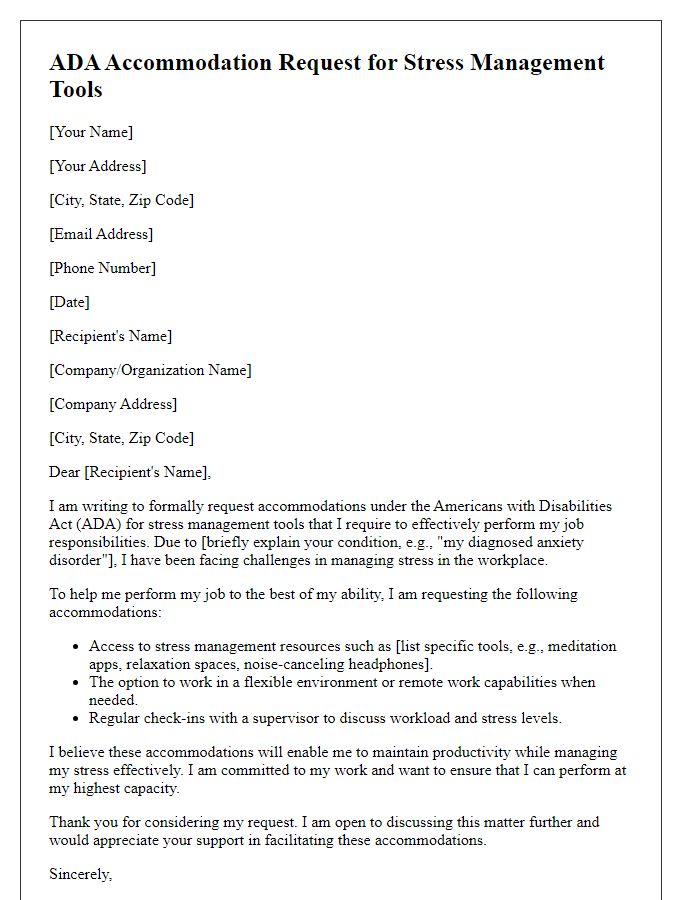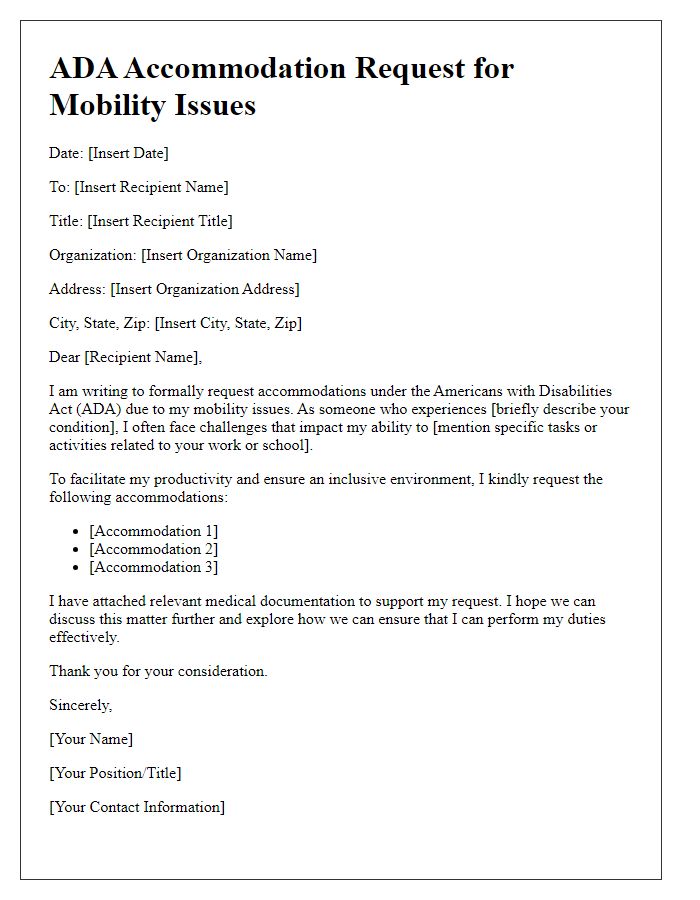Navigating the workplace can sometimes come with unique challenges, especially when it comes to ensuring everyone has the support they need. If you're seeking an ADA accommodation, it's essential to know how to effectively communicate your needs to your employer. A well-crafted letter can be a powerful tool in advocating for the adjustments that will enable you to perform at your best. Ready to learn how to put pen to paper and make your request clear? Let's dive in!

Employee's contact information and details
ADA accommodations are crucial for employees with disabilities to ensure equal access and opportunities in the workplace. The process typically begins with a formal request, which may include specific details regarding the nature of the disability, such as physical limitations, mental health conditions, or other qualifying impairments under the Americans with Disabilities Act (ADA). Providing employee contact information, such as name, department, and phone number, fosters direct communication with HR. Additionally, detailing the specific accommodations needed, like flexible work hours, assistive technology equipment, or modified workspaces, enhances understanding and expedites the review process. Clear documentation ensures that both employer and employee are aligned on expectations, ultimately promoting a more inclusive work environment.
Description of the disability or medical condition
Workplace accommodations for individuals with disabilities are crucial to ensure equal opportunities and accessibility. Conditions such as generalized anxiety disorder (GAD) can significantly impact an individual's ability to concentrate under pressure, affecting work performance in high-stress environments like corporate offices. Similarly, mobility impairments may require accessibility features such as wheelchair ramps or ergonomic office furniture, allowing individuals to navigate effectively within the workspace, like cubicles and common areas. Visual impairments necessitate assistive technologies, such as screen readers or Braille signage, to facilitate a smoother workflow in environments with substantial paperwork or digital tasks. Understanding these diverse needs is essential for creating an inclusive workplace that supports all employees' rights and fosters productivity.
Specific accommodation requested
Employees with disabilities may request reasonable accommodations under the Americans with Disabilities Act (ADA) to ensure equitable access in the workplace. Specific accommodations requested might include modifications to work schedules, such as flexible hours to accommodate medical appointments or adjusted start and end times for individuals with chronic fatigue. Additionally, physical changes in the workplace may be necessary, such as installing ramps or accessible bathroom facilities to assist those with mobility impairments. Providing specialized equipment, like ergonomic furniture or software that supports communication and productivity for employees with visual or hearing impairments, can also be requested. These accommodations aim to facilitate a more inclusive work environment, promoting autonomy and effectiveness for all employees.
Reason for the accommodation
Individuals with disabilities may require specific accommodations in the workplace to perform their job duties effectively. For instance, an employee with a visual impairment may need screen-reading software (such as JAWS or NVDA) to access digital content on their computer. A person experiencing chronic pain might benefit from an ergonomic chair to reduce discomfort during long hours of work. Reasonable adjustments, like flexible scheduling or remote work options, can significantly enhance productivity for employees with mental health conditions. These accommodations aim to create a more inclusive work environment, fostering equal opportunities for all employees in compliance with the Americans with Disabilities Act (ADA).
Supporting documentation or medical evaluation
The process of requesting ADA (Americans with Disabilities Act) accommodation in the workplace often involves submitting appropriate supporting documentation, which may include a medical evaluation. Employees must provide medical records or evaluations from licensed healthcare professionals, detailing the nature of the disability and how it impacts the ability to perform essential job functions. This documentation should specify the recommended accommodations, such as flexible work hours or specialized equipment, that would aid in improving job performance while ensuring compliance with ADA regulations. It is vital for employees to prepare a comprehensive packet that includes detailed information about their specific needs, any relevant medical history, and the proposed adjustments to facilitate effective communication with HR or management regarding the desired accommodations.
Letter Template For Requesting Ada Accommodation At Workplace Samples
Letter template of ADA accommodation request for neurodiversity support.

Letter template of ADA accommodation request for stress management tools.












Comments